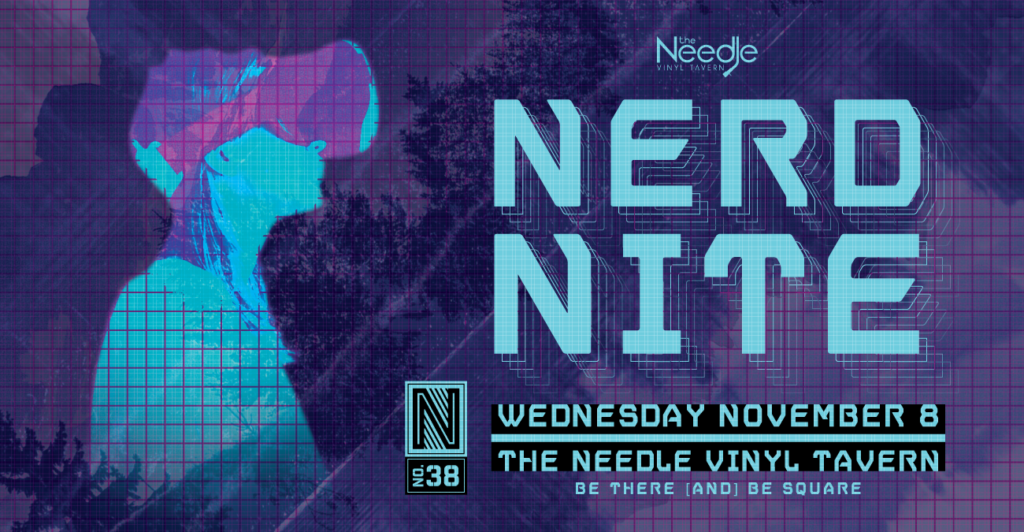Only, what? Like 37 days between NN #38 and Christmas? Well, you could worry about your Christmas shopping (or whatever occasion you celebrate around the Winter Solstice, up to and including the Solstice itself), or you could huddle close to some fellow nerds, and learn about things other people won’t even imagine… because they’ve never been to a Nerd Nite before!
Be there AND be square.
When: Wednesday, Nov 8, 2017 (show @ 8pm)
Where: The Needle Vinyl Tavern (10524 Jasper Avenue)
Tickets: on sale at YegLive.ca
$20 in advance
$10 peanut gallery tickets
[Must be 18 years or older]
Our line-up of talks includes:
How you get a Flesh Searing Relativistic Particle Cannon to Zap Cancer Cells
Chad Hay
Cancer sucks. There is a lot of fear and tragedy associated with this disease. This talk isn’t going there. Instead, we’ll explore External Beam Radiation Therapy, a very cool technology in the fight against cancer that is making it possible to view cancer as a chronic illness. Specifically, we’ll explore the moment when a patient is laying on the bed of a linear accelerator waiting for a beam of high-energy particles to destroy carefully targeted cancer cells in their body and what it takes to get this patient to that crucial point.
Chad Hay is a senior consultant with CancerControl Alberta. He has led a series of projects there focused on quality, efficiency and the patient experience. These include transitioning radiation therapy treatment delivery to a fully electronic process, implementing electronic prescriber ordering in a cancer centre, and optimizing the utilization models for Daycare chemotherapy delivery. The challenge has been getting brilliant clinicians to re-assess how they view their operations. The reward (beyond successful delivery) has been working with some amazing people and learning a tremendous amount from them, some of which I can now share with you.
Birds don’t give a Dam: Politics of wildlife conservation and developmental projects in the Himalayas
Titash Choudhury
Over the last decade, the Himalayas, has not only become a potential energy frontier to meet world’s surging energy demands, but an opportunity for those in the state seeking political and financial independence. Dams are celebrated and endorsed as a “clean” and “renewable” energy sources that ensure sustainable development, and politicians and major corporations are making promises of great economic benefits and job opportunities arising from these projects. However, rapid development, and the deficiencies of environmental and social impact assessment have provoked political and social debates in the region. Simultaneously, development in this biodiversity rich and geographically fragile region, has raised concerns among wildlife biologists, ecologists and experts resulting in ongoing interaction and negotiation between scientists or experts and the indigenous community. There are interesting parallels between resource politics in northern Alberta and the Himalayas on how different stakeholders such as developers, conservationists, government deploy narratives of change; articulate their respective claims over resources and the power relations within and between these different stakeholders.
Titash Choudhury recently completed her second Master’s degree in Environmental Anthropology from the University of Alberta. Her project was in the eastern Himalayas among the Monpa community. From working in the laboratory to doing fieldwork in one of the world’s largest stretch of mangrove forest, the Sunderbans Delta, she studied the human tiger conflict in the landscape. Currently Titash works with the City of Edmonton as a sustainable scholar to understand the perceptions of Edmontonians in regards to energy transition and the implication of the policies of the government on the community.
Learning to see culture: VR learning worlds in ethnographic film research
Michael MacDonald
The immediate response to my first short documentary film shot with a spherical VR camera was: “Whoa, I need to sit down, that made me feel sick.” Filming with a VR camera allows viewers with VR headsets to look around the video, no longer watching the screen from a distance, you are somehow located in an educational space. A VR pedagogical film is no longer passive, it creates a VR environment that students can explore. This is a new space for educational filmmakers, creating preplanned environments. For cultural studies researchers, it provides an opportunity to rethink how we make films and how we think about education. VR video has the potential to allow researchers to share fieldwork in radically new ways. And create an opportunity for students to experience activities and places, unlike anything previous fieldwork technology has allowed. Previous kinds of filmmaking, like Cinema Verite, worked to help the viewer feel like you were there. But VR learning worlds do it at an existential level that is nothing short of disconcerting.
Michael B. MacDonald is a filmmaker, ethnomusicologist, and associate professor of music in the faculty of Fine Arts and Communications at MacEwan University in Edmonton, Alberta, Canada. His research focuses on youth and community studies, ethnographic film, and the critical pedagogy of music. He has published two books: “Playing for Change: Music Festivals as Community Learning and Development” and “Remix and Life Hack in Hip Hop: Towards a Critical Pedagogy of Music”, and is the director of FreireProject.org. Michael’s films are freely available at www.michaelbmacdonaldfilms.ca
